Lockheed Martin Australia and Omni Tanker develop new composite tanks for cryogenic fuels
Partnership aims to commercialize Type IV and V tanks using patented OmniBIND technology for Lockheed Martin and NASA applications.

Linerless liquid hydrogen tank made using carbon fiber. Photo Credit: Advanced Manufacturing Growth Centre Ltd. (AMGC)
A collaborative partnership between Lockheed Martin Australia (Canberra), Australian manufacturer Omni Tanker (Smeaton Grange, NSW) and University of New South Wales (UNSW) seeks to develop and commercialize world-first composite tank technologies, thanks to a grant from the Federal Government’s Advanced Manufacturing Growth Centre (AMGC).
The co-funded project is part of AMGC’s Commercialization Fund launch and worth a total $1.4 million, will utilize two home-grown technologies to solve the challenges of using composites for the transportation and storage of liquid hydrogen with applications on ground, in the air, underwater and in space.
Combining nano-engineering technology developed by UNSW in partnership with Lockheed Martin and Omni Tanker, and Omni Tanker’s patented OmniBIND technology, the collaboration will result in the development of two new operational scale propellant tanks for storing cryogenic liquid fuels for commercial and civil satellite programs: a “Type IV” fluoropolymer-lined carbon fiber composite tank and a “Type V” linerless carbon fiber composite tank, both of which are suitable for high pressures, the extreme cryogenic temperatures required for liquid hydrogen as well as oxygen, hydrogen peroxide and hydrazine.

Large carbon fiber-reinforced composite pressure vessel. Photo Credit: Advanced Manufacturing Growth Centre Ltd. (AMGC)
Christopher Hess, head of industrial development for Lockheed Martin Australia acknowledged the support of AMGC and welcomed the opportunity for ongoing collaboration with UNSW and Omni Tanker.
“Lockheed Martin invests millions of dollars every year into R&D programs with our Australian industry and research partners to solve real challenges facing our Global Supply Chains,” he says. “We have had a long-standing research collaboration with UNSW and Omni Tanker, and we are grateful for the support of the AMGC as we now look to commercialize these cutting-edge, Australian-developed composite tank technologies for a number of Lockheed Martin and NASA applications.”
David Ball, regional director Australia and New Zealand for Lockheed Martin Space, confirmed that the development of composite tanks which are lightweight, cost-effective and resistant to microcracking and permeation, represents a unique and innovative technological solution with significant space applications.
“As the world increasingly looks to hydrogen for emission-free energy, containing and transporting it in a safe, cost-effective and economic manner remains extremely challenging,” says Ball. “The space industry is particularly interested in the development of linerless composite tanks for their weight efficiency and durability, which represent the cutting edge of composite pressure vessel manufacturing.
“These advances have the potential to support the growth of Australia’s sovereign space capabilities, strengthen exports to space-faring allies and partner nations and make an important technological contribution to future space missions particularly in on-orbit storage, launch and deep space exploration,” he continues.
“Creating a lightweight vessel for transporting liquid hydrogen at minus 253 degrees Celsius is no simple thing — whether you’re moving it along a highway or to outer space — but it’s Australian know-how that is making it possible,” says Dr. Jens Goennemann, managing director of AMGC. “That’s why AMGC is supporting Omni Tanker and its collaborative partners to engineer and manufacture a solution to this problem and offer it globally.”
The project builds on a recent invention by the research team at UNSW led by Professor Chun Wang, which enables carbon fiber composites to withstand liquid hydrogen temperatures without matrix cracks — a challenge that has, up until now, prevented mass-market adoption of these materials for such applications. “This new technology is the result of a collaboration and partnership between UNSW, Lockheed Martin and Omni Tanker over the past four years,” says Wang. “It is wonderful seeing our research achievement is now moving closer towards commercial success and generating social and economic impact in Australia and beyond.”
Omni Tanker, with its experience in the development and commercialization of strong, lightweight composite transport vessels, says it has the know-how and technology to translate the recent research innovations for a myriad of applications. “This next phase in our collaboration with Lockheed Martin and UNSW is a landmark development that sees Omni Tanker’s seamless thermoplastic lining technology enter the aerospace sector,” adds Omni Tanker CEO, Daniel Rodgers. “The OmniBIND technology has made inroads to revolutionizing the safe and efficient movement of challenging liquids within the chemical transport sector. Now, the growing need to decarbonize the energy industry, and the re-usable low-earth-orbit satellite market, have the potential to drive major utilization for these new technologies.”
Related Content
Near-zero erosion ultra-high temperature CMC
K3RX commercializes UHTCMC for a wide range of markets, demonstrating performance in prototypes, assemblies and advancing manufacturing to reduce cost.
Read MoreRevolutionizing space composites: A new era of satellite materials
A new approach for high volumes of small satellite structures uses low-CTE, low-cost CFRP cellular core, robust single-ply skins and modular panel systems to cut lead time, labor and cost for reflectors, solar arrays and more.
Read MoreOn the radar: Reusable launch vehicles, hypersonics make space more accessible
CFRP has become key to targeting efforts in reusing components like rocket stages, as well as the development of reusable hypersonic testbeds and spaceplanes, for increasing space commercialization.
Read MoreNASA launches composite solar sail into space
Sunlight-based propulsion system, supported by carbon fiber-reinforced booms, will undergo weeks-long testing to demonstrate and verify its capabilities.
Read MoreRead Next
Carbon fiber composite liner-less pressure tank handles cryogenic temps
Cimarron Composites has made a leap forward in all-composite cryogenic tank development.
Read MoreScaling up, optimizing the flax fiber composite camper
Greenlander’s Sherpa RV cab, which is largely constructed from flax fiber/bio-epoxy sandwich panels, nears commercial production readiness and next-generation scale-up.
Read MoreUltrasonic welding for in-space manufacturing of CFRTP
Agile Ultrasonics and NASA trial robotic-compatible carbon fiber-reinforced thermoplastic ultrasonic welding technology for space structures.
Read More












